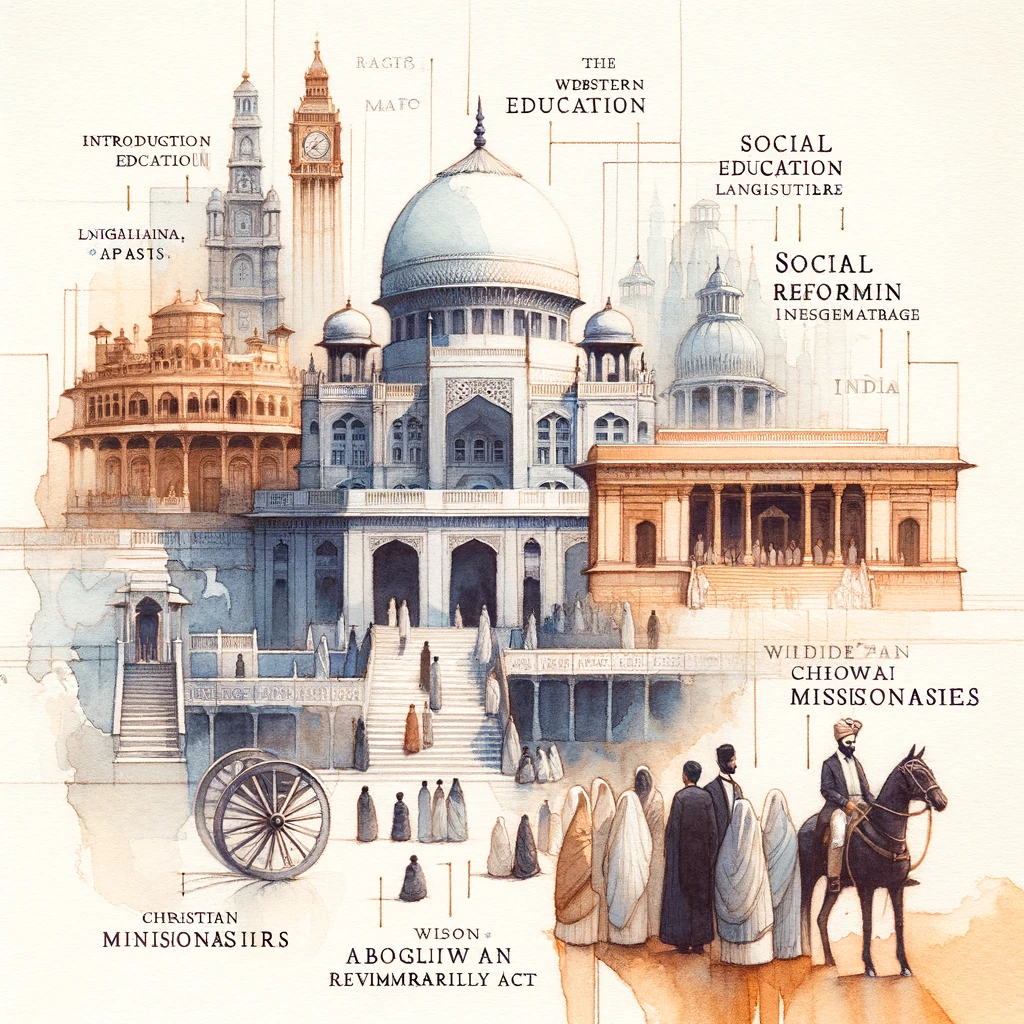The profound social and cultural effects of colonialism reshaped Indian society in numerous ways. These changes were brought about through the introduction of Western education and the English language, various social reforms and legislative measures, and the influence of Christian missionaries. This article explores these aspects in detail.

Introduction of Western Education and the English Language
1. Western Education:
- The introduction of Western education was one of the most significant impacts of British colonial rule. The British aimed to create a class of educated Indians who could assist in the administration of the colony and serve as intermediaries between the British rulers and the Indian populace.
- Lord Macaulay’s Minute on Education (1835) played a pivotal role in this transformation. Macaulay advocated for the promotion of English as the medium of instruction and the introduction of Western curricula. He believed that English education would help in creating a class of Indians who were “Indian in blood and color, but English in taste, in opinions, in morals, and intellect.”
2. English Language:
- The promotion of the English language had far-reaching effects. It became the medium of instruction in schools and colleges and the language of administration, law, and commerce. English facilitated communication across diverse linguistic regions of India and opened up opportunities for Indians to participate in the global economy.
- English education also played a crucial role in the rise of a new educated elite in Indian society. This group became instrumental in the social, political, and intellectual awakening of the country. Figures like Raja Ram Mohan Roy, Dadabhai Naoroji, and later leaders of the Indian National Congress were products of this educational system.
Social Reforms and Legislative Measures
The British colonial period also witnessed significant social reforms, often driven by Indian reformers and supported by colonial authorities. Some key legislative measures include:
1. Abolition of Sati:
- Sati, the practice where a widow immolates herself on her husband’s funeral pyre, was a deeply entrenched social custom in certain parts of India. Reformers like Raja Ram Mohan Roy campaigned vigorously against it.
- The practice was abolished by the British through the Bengal Sati Regulation, 1829, under the Governor-Generalship of Lord William Bentinck. This law marked a significant step towards eradicating this inhumane practice.
2. Widow Remarriage Act:
- Widows in traditional Indian society were often subjected to harsh social ostracism and denied the right to remarry. Reformers like Ishwar Chandra Vidyasagar advocated for the rights of widows. The Widow Remarriage Act of 1856, passed under the administration of Lord Dalhousie, legalized the remarriage of Hindu widows and aimed to improve their social status. This legislation was a landmark in the fight against social oppression.
3. Other Social Reforms:
- The British also enacted laws against female infanticide, child marriage, and the practice of Thuggee (organized robbery and murder). These measures were aimed at curbing practices that were considered barbaric and detrimental to social progress.

Influence of Christian Missionaries
Christian missionaries played a significant role in the social and cultural landscape of colonial India. Their influence extended beyond religious conversion to various aspects of social and educational development.
1. Education and Healthcare:
- Missionaries established numerous schools, colleges, and hospitals across India. Institutions like Serampore College, St. Stephen’s College, and the Christian Medical College in Vellore are legacies of missionary efforts in education and healthcare.
- The focus of missionary education was often on providing basic literacy and vocational training, as well as higher education. This contributed to the spread of Western knowledge and ideas among Indians, especially in rural and underprivileged areas.
2. Social Reforms:
- Missionaries actively campaigned against social evils such as caste discrimination, slavery, and the subjugation of women. They provided support and rehabilitation for converts who often faced social ostracism and economic hardship.
- They also promoted women’s education and healthcare, setting up girls’ schools and women’s hospitals. This had a significant impact on the status and empowerment of women in Indian society.
3. Cultural Exchange and Dialogue:
- While the primary aim of missionaries was religious conversion, their interactions with Indian society led to a cultural exchange. Many missionaries learned local languages and studied Indian religions and philosophies, contributing to a greater understanding and dialogue between the West and India.
- Some missionaries, like William Carey, translated the Bible into various Indian languages, which also involved creating dictionaries and grammar, thus aiding in the development of Indian linguistic studies.
Conclusion
The social and cultural effects of colonialism in India were complex and multifaceted. The introduction of Western education and the English language, social reforms and legislative measures, and the influence of Christian missionaries collectively contributed to significant changes in Indian society. While these changes brought about progress and modernization in some areas, they also led to social upheaval and resistance. Understanding these effects of colonialism is crucial for comprehending the historical trajectory of India’s social and cultural development during the colonial period and beyond.


